 |
 |
 |
[ Go to Bottom ]
-
 |
 |
 |
[ Go to Bottom ]
*** Welcome ***
to the Ba Gua Zhang (Pa Kua Chang) Website of Sifu Park Bok-Nam!
We hope that you will find this site to be interesting and informative,
and will use it as a starting point for
learning
more about the Ba Gua Zhang of Lu Shui-Tian.
|
= THIS EDITION = Featured in this edition of the FYI Page: (CHI KUNG) PRACTICE . |
= ANNOUNCEMENTS =
-
|
= Berkshire, ENGLAND on October 16 & 17, 1999 = Check the Seminars/Training Camps page for contact information. |
|
|
It may be ordered directly from the Italian publisher: = EDIZIONI MEDITERRANEE =
Or, it may be ordered from quality Italian bookstores both online and off. |
|
|
THE GOALS OF QI GONG (CHI
KUNG)
PRACTICE
Bok-Nam Park
[Adapted and re-edited by F.
Hriadil]
| The specific
goals of Qi
Gong (Chi Kung) practice may vary from one discipline to another;
however
in general, the martial arts practitioner will first want to develop
and
promote overall health and well-being by seeking a balanced
distribution
of energy in the body and by improving the body's efficiency in terms
of
energy movement and usage. This will include methods aimed at
integrating
and harmonizing
the MIND + the BODY + the BREATH utilizing a safe, gentle, and well-balanced approach. Balance, efficiency, and a natural approach are the key elements to building a body which is strong internally. If the body's internal systems are not balanced in terms of energy production, distribution, and consumption; then, the body is not working optimally and any attempt at utilizing internal energy in a martial art or healing practice will only cause further imbalance that can eventually damage the body's internal systems. |
| Only when the body is working in a
balanced,
efficient, and natural manner should the Qi Gong (Chi Kung)
practitioner
pursue "energy cultivation," "energy refinement," building a stronger
energy
reserve, or using internal power in martial arts.
"If a dam has a leak, you do not fill the reservoir with water until the dam is fixed." This is just common sense; however, there are many practitioners who practice "power" Qi Gong (Chi Kung) methods before their body is fully balanced and operating efficiently. Their power is transmitted through a system which is not internally connected and internally balanced and, as a result, their weak structure can become shocked and damaged. This is analogous to overloading an electrical circuit - the body will eventually "blow a fuse." |
| Power Qi Gong (Chi Kung) methods should only be practiced afer the student has had a great deal of experience with the much gentler Energy-balancing Qi Gong (Chi Kung) methods. This is one reason why all Ba Gua Zhang (Pa Kua Chang) students following the method of Lu Shui-Tian first practice every exercise "slowly and exactly" before they try to add power to the movement. The body must be internally connected and internally balanced before power training can be properly initiated. Training for power without slowily progressing through a systematic series of proper exercises would be analogous to running a 26 mile marathon without ever having done any type of jogging or running prior to the event. The end result would be a body that has become severely damaged. |
| Unfortunately, the damage which can be done by the inappropriate practicing of Qi Gong (Chi Kung) does not usually manifest itself right away. Energy changes in the body are subtle and gradual. Unless the practitioner is under the guidance of an experienced instructor or skilled Chinese medical doctor, the signs of dysfunction can go unnoticed until they are blatant enough to be physiologically confirmed. At this point, the damage is done and can take a long time to correct. |
| Master Park had a student in Korea who learned a number of Qi Gong (Chi Kung) exercises from him and then got a job working on a merchant ship. This student practiced on his own while he was at sea for a year or so, without heeding the guidance and warnings of Master Park, and over-trained. As a result of his over-doing the exercises, this student developed serious problems. He experienced dizziness, headaches, buzzing noises in his ears, and loss of balance. When he returned home, this student came back to Master Park and described his problems. Master Park was then able to help the student back to health, but it took a great deal of time and effort to do so. Too much of a good thing can cause problems because the body lacks balance. Internal damage is not easy to fix. |
| While any practitioner is involved in Qi Gong (Chi Kung) training, he or she must be closely monitored by a knowledgeable instructor to insure that there are no problems in the process. If the student is not participating in a complete and comprehensive method of Qi Gong (Chi Kung) practice under the guidance of an expert instructor, and if the student is not properly monitored throughout the process or does not know the next step in the training which must occur after obtaining certain results, significant problems can begin to arise. Because of the major effect and influence any significant energy movement or release in the body can have on the state of the physical body, mind, spirit, and emotions, there must be a systematic method in any Qi Gong (Chi Kung) training which properly balances, completes, varies, or continues the process based on the results when each such milestone is reached. If an energy gate, point, or center is opened as a result of training and the practitioner does not know how or when the training needs to progress to the next stage, at best he or she will stagnate in the training, and at worst, will create a disharmonious condition within his or her body. |
| This is so important that it must be repeated again. When a significant energy event (energy movement, opening, or release) occurs in the body and the student is not taught how to advance from that experience, problems can and will arise. Unfortunately, these types of energy events may feel very good to the practitioner because there can be an associated "endorphin rush" when the energy is released. Students who cling to this experiecne and do not look past it to the next level will stagnate in their training and can sometimes create a "Shen disturbance" condition by fixating on trying to repeat that one experience in every training session. |
| "Power" Qi Gong (Chi Kung) methods form an inherent element of the Ba Gua Zhang (Pa Kua Chang) of Lu Shui-Tian. If any practitioner wishes to use internal power and energy to harm an opponent in combat, then, the practice of internal methods specifically designed to teach the student how to use internal energy and power in striking is necessary. In the Ba Gua Zhang (Pa Kua Chang) of Lu Shui-Tian, the "Forty-Eight Month" Palms exercises comprise part of the power training method. They are designed to teach the student how to issue internal energy in combat strikes. On the other hand, even those students who are not interested in combat, who are only interested in Qi Gong (Chi Kung) for health purposes, must still practice power methods such as the Du Zhang ("Shaking Palms") exercises because these methods aid in opening the energy channels in the body and help to develop the Tan Tian. [For more information on the "Forty-Eight Month" Palms and the Du Zhang ("Shaking Palms") exercises refer to: "Mythical Power of the Palm" from FYIPage Back Issue - Edition: 6, August 1998 listed on the Reference Information page.] But, as stated previously, no student should jump right into practicing these methods. There should be a gradual, systematic, developmental process taught by an instructor who knows how to evaluate and adjust the training to each student's individual needs. |
|
|
| Many martial artists and Chinese medicine doctors "burn themselves out" because they do not balance their practice between energy usage and energy rebuilding/balancing. A good internal martial arts instructor, one who has a complete method, must know how to properly balance a student's energy practice. This is essential. In the Ba Gua Zhang (Pa Kua Chang) of Lu Shui-Tian, both Yang Training Methods and Yin Training Methods are incorporated so that all of the Power Methods are properly balanced by appropriate Energy-building Methods. |
| In Qi Gong (Chi Kung) practice, as it relates to the martial arts, there must be a systematic process of training which begins with a program of balancing the body's energy, structure, and movement, and then continues with exercises designed to build internal strength while maintaining that balance. Once these two goals are accomplished, the practitioner can then start to learn how to use that energy for martial purposes and martial power. |
| However, once the student begins this power training, it is vital that he or she continue to balance the training with rebuilding and cultivation methods. The number one priority is to maintain a strong, healthy, and balanced internal system, not to see how much "power" one can obtain. |
Note: [For more
information about
Ba Gua Qi Gong (Chi Kung) training refer to:
|
Master Bok-Nam Park's Ba
Gua
Zhang
1999 SUMMER TRAINING CAMP
- [ June 11 to June 15 ] -
Below are some pictorial highlights from this year's camp!
.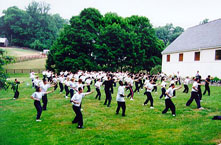 .=
.=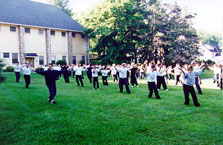 .
.
Ba Gua Basic Training
Ba Gua Qi Gong Training
.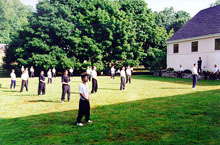 .
.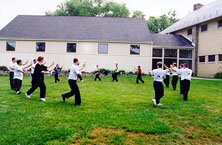
Ba Gua Breathing & Meditation
Ba Gua Circle Walking Practice
.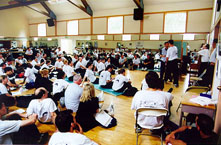 .
.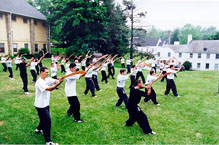
Ba Gua Theory and Principles
Ba Gua Weapons Training
..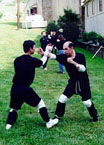
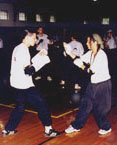 .
.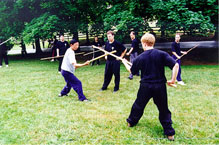
Ba Gua Research Sparring
Ba Gua Weapons Sparring
Don't miss out on the most concentrated and
comprehensive
Ba Gua Zhang training camp in the world!
Keep your calendars open for June 9 - 13, 2000 so that you'll be sure to make it next year.
= = =
[ Go to Top
] [ Return
to
This
Edition Index ] [ Go To
Bottom ]
=== Suggestions to improve this site are always welcome ===
Submit any comments, suggestions, etc. to E-Mail:
[ Go to Top ]
 |
 |
 |